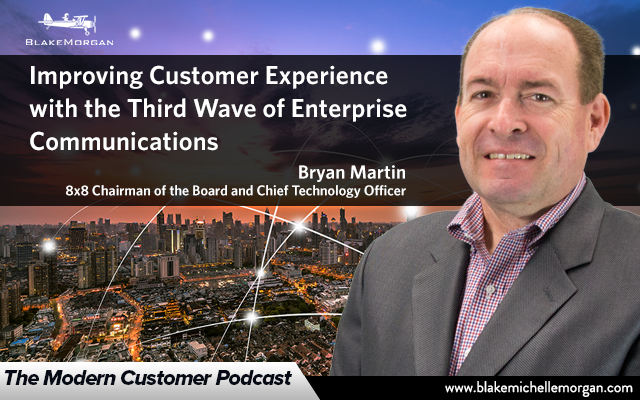There’s no doubt that customer experience is changing. Perhaps one of the most surprising aspects is that it is changing so quickly. In order to keep up with the rate of change and ensure customers’ needs are met, companies need to embrace a new wave of technology.
In many cases, customer experience is only as good as a company’s data and communication system. Think of how we communicate: we use text, chat, email, phone, and more. If that’s how customers talk, it’s also how companies should listen. Yet many times communication is lacking and actually contributes to a bad customer experience.
Bryan Martin, Chairman and CTO at 8×8, likes to think of business communication in terms of waves. The first wave was on-premise and hardware-based with heavy infrastructure. Companies likely had a different vendor for each aspect of their communication and data storage, which meant things were disjointed and inefficient. In the second wave, point solutions moved to the cloud, which didn’t really solve any problems except for making the solutions less expensive. We’re now in the third wave, which is transforming how businesses operate, store data, and communicate with customers. In the third wave, companies have a single enterprise cloud solution that covers all customer and employee interactions. The single platform enables communication while also engaging with customers and storing data for the entire company to access. Taking advantage of the third wave helps companies accelerate their businesses, gain more revenue, and see higher NPS scores. According to Bryan, the third wave will continue to grow as more people realize that all communications need to be connected.
Using different tools creates silos within an organization. If the contact center uses one program to manage its phone calls and the digital team uses another program to manage social outreach and customer data, everything falls into different categories and can’t be connected to create a consistent customer experience. Imagine the frustration for customers who can’t have their issues solved right away and for employees who don’t have the tools they need to best meet customers’ needs. Those problems are fixed with a unified enterprise system.
Contact center agents are always on the front line of communicating with customers. However, these agents aren’t effective at their jobs if they don’t have real-time access to other parts of the company. For too long contact centers have been their own islands without any connection to a common corporate directory or shared information. However, by connecting the entire organization to the same cloud-based data system, contact center agents can not only be aware of the context of their calls and better serve customers, they can play a vital role in driving customer experience and increasing sales.
There are lots of different channels companies use to communicate with customers, but technology is the glue that holds it all together. With the vast amount of data available today, companies should be able to understand and process customer needs in real time and know the history and context of each customer interaction. With the help of connected technology, the entire organization can be constantly improving.
Many companies think that changing their system and moving to the third wave is complicated and expensive. However, companies like 8×8 provide a variety of simple options. Investing in a unified engagement system has a high ROI as it accelerates business and improves customer experience.
In today’s world, technology is a vital part of customer experience. As Bryan says, the data scientist plays as important a role in customer experience as does the contact center agent. Taking advantage of technology and breaking down silos to create a unified, data-driven system allows companies to put customers first and drive their own business towards the future.
Disclosure: This is a podcast and post sponsored by 8×8.

